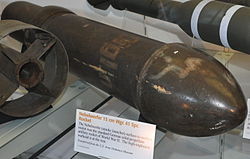15 cm Nebelwerfer 41
| 15 cm Nebelwerfer 41 | |
|---|---|
 A 15 cm Nebelwerfer 41 launcher while reloading. | |
| Type | Rocket artillery |
| Place of origin | |
| Service history | |
| In service | 1941—45 |
| Used by | |
| Wars | World War II |
| Production history | |
| Designed | late 1930s—1944 |
| No. built | 345 |
| Specifications | |
| Mass | 1,130 kilograms (2,490 lb) (empty) |
| Caliber | 590 |
| Barrels | 6 |
| Elevation | +13° 30' to +45° |
| Traverse | 22° 30' |
| Muzzle velocity | 145 metres per second (480 ft/s) |
| Maximum firing range | 1,925 metres (2,105 yd) (15 cm) 2,200 metres (2,400 yd) (15 cm) |
The 15 cm Nebelwerfer 41 (15 cm NbW 41) was a German multiple rocket launcher used in the Second World War. It served with units of the Nebeltruppen, the German equivalent of the U.S. Army's Chemical Corps. Just as the Chemical Corps had responsibility for poison gas and smoke weapons that were used instead to deliver high-explosives during the war, so did the Nebeltruppen. The name "Nebelwerfer" is best translated as "fog thrower" or "smoke thrower".

Rocket development had begun during the 1920s and reached fruition in the late Thirties. These offered the opportunity for the Nebeltruppen to deliver large quantities of poison gas or smoke simultaneously. The first weapon to be delivered to the troops was the 15 cm Nebelwerfer 41 in 1940, after the Battle of France, a purpose-designed rocket with gas, smoke and high-explosive warheads. It, like virtually all German rocket designs, was spin-stabilized to increase accuracy. One very unusual feature was that the rocket motor was in the front, the exhaust venturi being about two-thirds down the body from the nose, with the intent to optimize the blast effect of the rocket as the warhead would still be above the ground when it detonated. This proved to greatly complicate manufacture for not much extra effect and it was not copied on later rocket designs. It was fired from a six-tube launcher mounted on a towed carriage adapted from that used by the 3.7 cm PaK 36 to a range of 6,900 metres (7,500 yd). Almost five and a half million 15 cm rockets and six thousand launchers were manufactured over the course of the war.
External links
- Germany's Rocket and Recoilless Weapons from the U.S. Intelligence Bulletin, March 1945
- 15 cm Nebelwerfer 41, Catalog of Enemy Ordnance, 1945.
